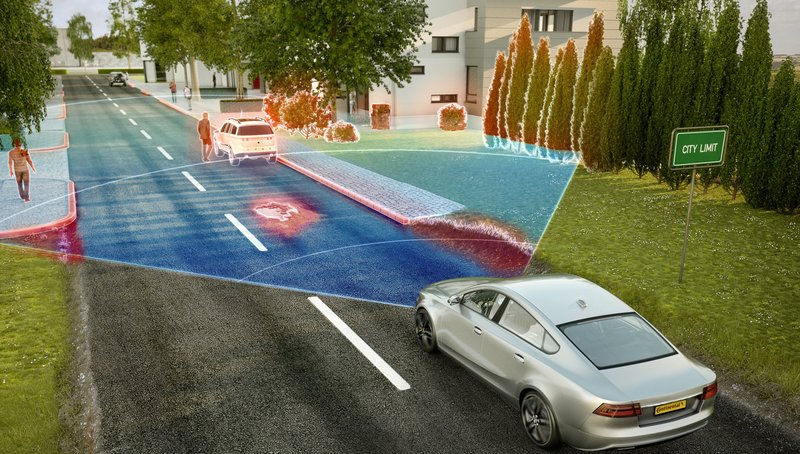From Convenience to Increased Safety: 20 Years of Continental Long-range Radar in Series Production
- World’s first long-range radar launched in 1999
- System from Continental used to regulate adaptive cruise control
- Key building block in furthering safety and reaching automated driving
AUBURN HILLS, Mich., November 13, 2019. Automated driving is coming – and with it, more powerful systems that enable vehicles to monitor and safely navigate their surroundings. One such enabler is Continental’s ARS540 fifth generation long-range radar, with a range of up to 300 meters and unprecedented resolution. Also for the first time, this radar will have both a horizontal and precise vertical resolution. Without it, automated driving may not be possible – something nobody could have predicted when the first factory-built vehicle equipped with long-range radar came onto the market 20 years ago. Continental played a key role in this joint development with Mercedes: in the Mercedes S-Class (W220 series), Daimler offered its adaptive cruise control (ACC) system under the name "Distronic" for the first time in 1999. It was the first ACC system in the world to use long-range radar. Its range at the time was 150 meters, making it the most advanced system of its day.
“With this system we broke new technological ground. Since then, over 50 million long- and short-range radar sensors have been produced by Continental – and the latest fifth generation long-range radar is being launched just in time for its 20th anniversary,” said Amit Kapoor, head of Advanced Driver Assistance Systems for Continental, North America.
Increased functionality in light, darkness and fog
Long-range radar systems are a standard feature in many modern vehicles. They ensure greater ride comfort by enabling ACC, as well as improved safety by activating the emergency brake assist in the event of danger.
The first generation of long-range radar was a complex system consisting of two components – the radar head, positioned behind the radiator grille and a control unit inside the vehicle. Both components were about the size of a shoe box and weighed less than 3 lbs. Thanks to a more powerful semiconductor and other integration measures, the entire radar system was halved in Continental’s second-generation long-range radar, now fitting into a housing slightly bigger than a thick paperback book, and weighing around 1.4 lbs.
With each generation, the long-range radar has become more compact, less expensive and more powerful, which is especially reflected in its greater range and higher resolution. The semiconductor technology, which is the key component, has also been modified several times.
“The complementary metal-oxide radio frequency (CMOS FR) technology, which is being used for the first time in the fifth generation, allows us to combine all functions on a single chip, reducing installation space and costs in the future,” explained Kapoor.
Radar data to be analyzed using artificial intelligence in the future
The continuous improvement in hardware is just one aspect of radar development. The other is the constant optimization of software, involving more precise algorithms. Ultimately, it is these programs that filter out objects relevant for safer driving from the radar sensor’s increasingly high-resolution data.
In the future, artificial intelligence will also be used to identify complex situations, like reliably detecting the tail of a traffic jam under a bridge. It will learn to recognize objects in traffic scenarios based on large volumes of data. With its capability to provide both a horizontal and precise vertical resolution, the fifth generation radar will enable new exciting features, for example, detecting road debris and operating the advanced driver assistance systems, if needed.
Long-range radar – a key component in safety and automated driving
According to the National Highway Safety Transportation Association, there are approximately 1.7 million rear-end crashes on U.S. roads each year, and about 400,000 of those result in injury. When the new ACC function went into production 20 years ago, it was a convenience feature. A short time later, the radar sensor technology was also used for emergency brake assist systems – an important building block toward automated driving. Future development will include increasingly precise vehicle surroundings monitoring, where radar, lidar and camera data are combined to generate a detailed and seamless view of the entire vehicle vicinity. By combining sensors, the aim is to achieve an understanding of the vehicle’s surroundings, which is as good as or better than human perception.
Long-range radar will also be used to enable a rear-viewing function in the future. If automated vehicles change lanes independently, they must be able to identify precisely whether and how fast other road users are approaching from behind. Two decades after its world premiere, Continental’s long-range radar has become a key component in increasing safety and automated driving.
“Continental believes in a building-block approach to automated driving, allowing people to adapt to automation as it progresses, and ACC is an important part of that approach,” Kapoor added. “Consumer acceptance of advanced and automated safety technologies is key to achieving Vision Zero, and that acceptance starts with education.”
To support this effort, Continental launched #SafelyThere, a consumer education campaign focused on building consumer trust and awareness of advanced driver assistance systems and automated driving technologies. Check out the #SafelyThere website for easy-to-understand technology overviews and to join the conversation.
Continental develops pioneering technologies and services for sustainable and connected mobility of people and their goods. Founded in 1871, the technology company offers safe, efficient, intelligent, and affordable solutions for vehicles, machines, traffic and transportation. In 2018, Continental generated sales of €44.4 billion and currently employs more than 244,000 people in 60 countries and markets.
For Continental, automated driving is an essential building block of future mobility. It will significantly change people’s journeys, for example, on the highway, in the city, and when parking. In 2012, Continental became the first automotive supplier worldwide to receive a license for highly automated test drives on public roads in the US state of Nevada. Sensors, control units, brake systems, software, connectivity solutions, driving functions as well as information and control systems for automated driving are developed in a global network focusing on Japan, China, the USA, India, and Europe. In the future, this will enable a wide range of solutions between partially automated and driverless vehicles. The aim is a seamless, efficient, sustainable, and comfortable mobility without crashes.

Mary Arraf
Head of Communications Automotive and Continental North America



